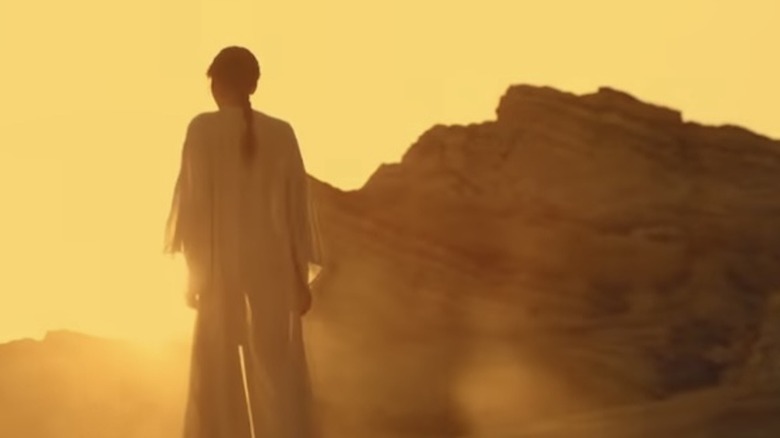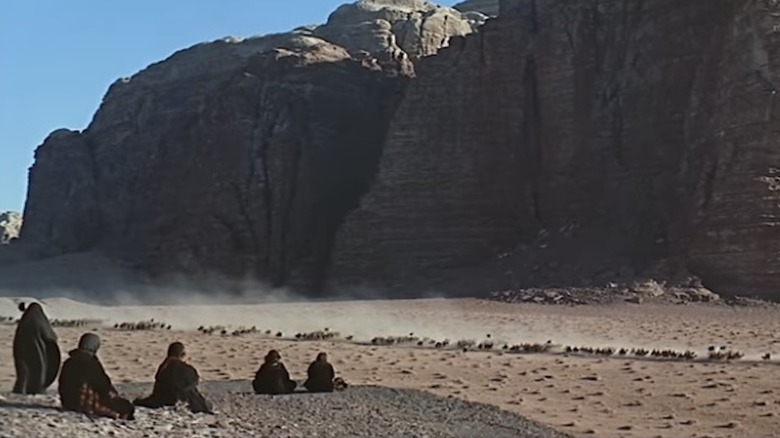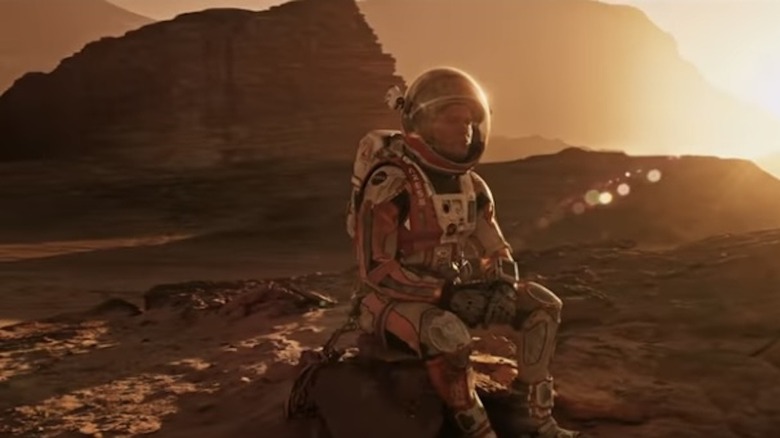The Real-Life Desert Used For Dune Had Already Made Hollywood History
In 2018, director Denis Villeneuve and his production designer Patrice Vermette wanted a bird's eye view of Jordan's Wadi Rum desert as part of a scouting mission for their sci-fi epic, "Dune." As their helicopter ascended over the barren landscape, they spotted a caravan of black SUVs making their way through the craggy rock formations (via The Hollywood Reporter). While their guide from Jordan's film commission told them that no other film crews were shooting at the moment, one could very well bump into another Hollywood production in what has become the Middle East's backlot.
Since 1962's "Lawrence of Arabia," the Wadi Rum desert has emerged as the go-to location for movies set in the Arab world or on alien planets, from Ridley Scott's 2015 film "The Martian" to the "Star Wars" franchise. The extraterrestrial atmosphere is in the desert's own moniker, which is often referred to as "the valley of the moon."
Villeneuve's scouting mission for "Dune" wasn't his first trip to the famed desert. Ten years earlier, he had visited Wadi Rum while scouting locations for his 2010 Oscar-nominated film "Incendies," a drama about a pair of twins that jumps between Quebec and the Middle East. Wadi Rum wasn't the right fit for "Incendies," Villeneuve said in an interview with The Hollywood Reporter, but he vowed to return there if he ever got the chance to film his dream movie, an adaptation of Frank Herbert's 1965 novel, "Dune."
"The rock formations are so strange and beautiful [...] exactly as I imagined them when I read 'Dune' as a teenager. And the quality of the light and the enormous scale of everything — you have an encounter with nature there that fills you with humility."
'Vast and echoing and God-like'
British archaeologist T.E. Lawrence introduced Westerners to Wadi Rum in his 1922 memoir, "Seven Pillars of Wisdom," which recounted his experience as a military advisor to the Bedouins during the Arab revolt against the Ottoman Empire between 1916 and 1918. The book would inspire the film starring Peter O'Toole, and Lawrence's own description of Wadi Rum as "vast and echoing and God-like" now reads like an advertisement to location scouts seeking out an ethereal backdrop. The endless expanse of sand is best captured by "Lawrence of Arabia" cinematographer Freddie Young, whose wide lens isolated O'Toole among red dunes and below towering cliffs. Even in epic battle scenes, human masses and herds of camels are dwarfed by the sheer size of the desert.
Despite its legendary place in cinema history, tourists and filmmakers alike temporarily abandoned Wadi Rum for greener (or drier) pastures. By 2015, the fallout in neighboring countries from the Arab Spring and war against the Islamic State had gutted Jordan's tourism industry, cutting visits to Petra (another site frequented by Lawrence, as well as fictional archaeologist Indiana Jones) in half.
The Jordanian government and the Royal Film Commission tried to capitalize on the country's supernatural landscape as a ploy to attract British tourists with a U.K. media blitz declaring that their country was "literally out of this world." The slogan was a shrewd move by Jordanian officials, and it's clear the government sees Hollywood as a potential cash cow. In an effort to compete with Abu Dhabi's 30 percent tax rebate, the Jordanian government announced in 2014 that certain productions could receive tax exemptions, and in 2019, the government raised the cash rebate on qualifying productions from 20 percent to 25 percent.
Red planet
Wadi Rum's red sands, which get their crimson color from iron oxide, have made the desert a perfect stand-in for Mars or the fictional "Star Wars" planet Pasaana. "The Martian" also inspired a series of domed, astronaut-worthy tents that popped up in Wadi Rum known as "Sun City."
The desert may look like another world to moviegoers, but for Oscar Isaac, the colossal rocks and red, sweeping sands feel familiar. Within the span of four years, the actor shot "Star Wars," "Dune," and the Marvel series "Moon Knight," which references Egyptian history, across the desert. As he said in the "Moon Knight" press notes:
"They even still have the roads named after the 'Star Wars' film that I did there, so it felt like a reunion to go back there and see some of the same people that I'd seen when I was there before. It's a spiritual feeling to be out in that vastness. It reminds you of your place in the cosmos."
Though its sands had been tread before, setting up shop in Wadi Rum wasn't easy for the "Star Wars" cast. Some of the roads slicing through the desert weren't just named after the "Star Wars" production but were carved by them. Before filming "The Rise of Skywalker," director J.J. Abrams' crew constructed miles of road into Wadi Rum (via Vanity Fair).
"They basically had to set up a small town out there, populated by the cast and extras and crew — the creature-effects department alone had 70 people. The Jordanian military got involved. The Jordanian royal family got involved. There was sand. There were sandstorms, when all you could do was take cover and huddle in your tent and — if you're John Boyega, who plays the ex-Stormtrooper Finn — listen to reggae."
It took a herculean effort to bring the massive "Star Wars" cast to the middle of Wadi Rum, but it's not just tax incentives that entice filmmakers to the Jordanian desert. From "Lawrence of Arabia" to "Dune," the otherworldly red sands still have the ability to transport audiences to Mars, Pasaana, Egypt, and beyond.


